Camp Nou: FC Barcelona
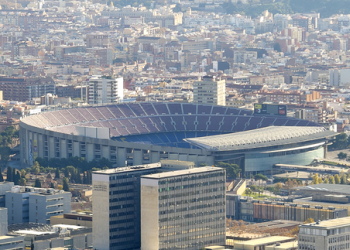
In the Santiago Bernabéu and the Nou Camp, Spain boast two of the most iconic football stadiums anywhere in the world. Arguably only Anfield and Old Trafford are as well known and revered as the grounds that belong to the two Spanish giants. The home of FC Barcelona is the largest capacity football stadium in Spain, able to hold just under 100,000 spectators for the Blaugrana’s games. It is the second largest soccer stadium in the world, missing out to Pyongyang’s Rungrado May Day Stadium that can hold a phenomenal 150,000 people. Then again it is in North Korea, so it’s possible it can only hold one person and there’s just loads of mirrors to make it look massive.
As well as hosting Barca’s matches the Nou Camp has also been used to host international matches for the 1982 FIFA World Cup Final as well as the football matches for the 1992 Summer Olympic Games. It has held two UEFA Champions League finals ten years apart. The first saw Milan beat Steaua București in 1989, whilst the second saw Manchester United score two goals in stoppage time at the end of the game to overturn Bayern Munich’s 1-0 lead. As well as hosting matches for the 1982 World Cup the ground was also used to host the opening ceremony for the competition.
It is currently sponsored by Spotify on a 12 year deal.
Stats
| Camp Nou Stats | |
|---|---|
| Year Opened | 1957 |
| Capacity | 105000 |
| Average Attendance | 0 |
| Record Attendance | 120000 (Barcelona v Juventus (1986)) |
| Pitch Size | 105 x 68 (7140) |
| Nickname | Nou Camp |
| Former Name | Estadi del FC Barcelona, Estadio del CF Barcelona |
| Owner | FC Barcelona |
| Sponsor | Spotify |
| Clubs Hosted | FC Barcelona |
| First Fixture | Barcelona v Legia Warsaw (24/09/1957) |
| Barcelona Stats | |
|---|---|
| Year Founded | 1899 |
| Nickname | Barça, Blaugrana |
| Club Mascot | L'avi del Barça |
| Rivals | Real Madrid, Espanyol |
| Previous Stadiums | Camp de la Indústria, Camp de Les Corts |
| Kit | Blue & Red Stripes (Home) / Lilac (Away) / Blue with Red Detail (Third) |
| Training Ground | Ciutat Esportiva Joan Gamper |
| Shirt Sponsor | Spotify |
| Team Owner | Barcelona Socios |
| Record Goalscorer | Lionel Messi (499) |
| Record Appearances | Xavi Hernández (767) |
Camp Nou Photos
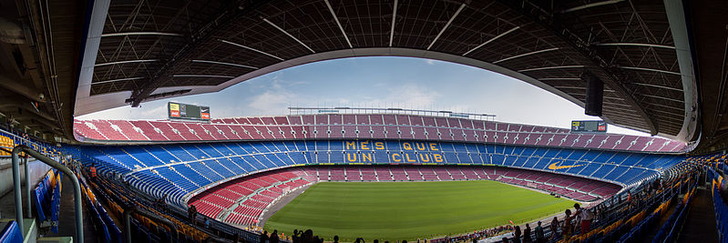
By Johannes Falke (Own work) [CC BY-SA 3.0]
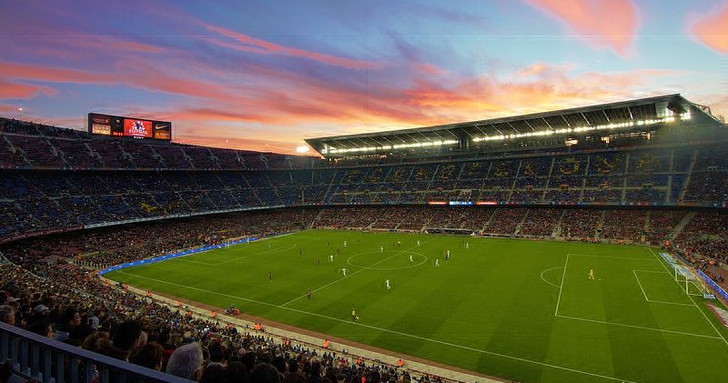
By Teakjun (Own work) [CC BY-SA 4.0]
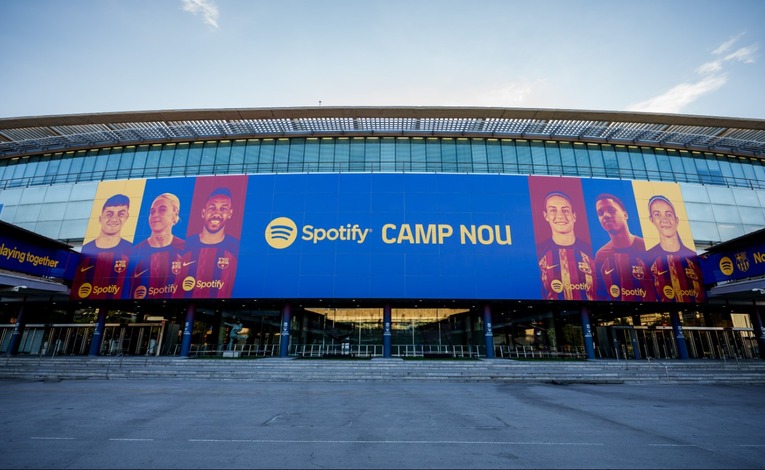
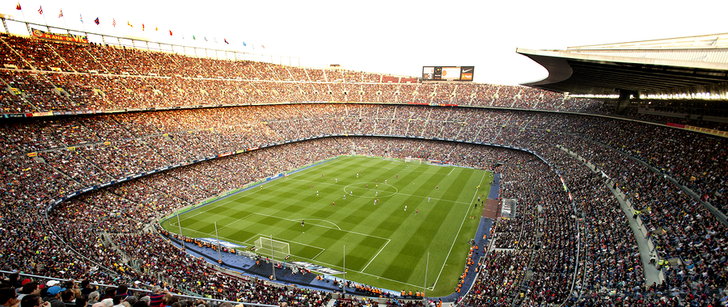
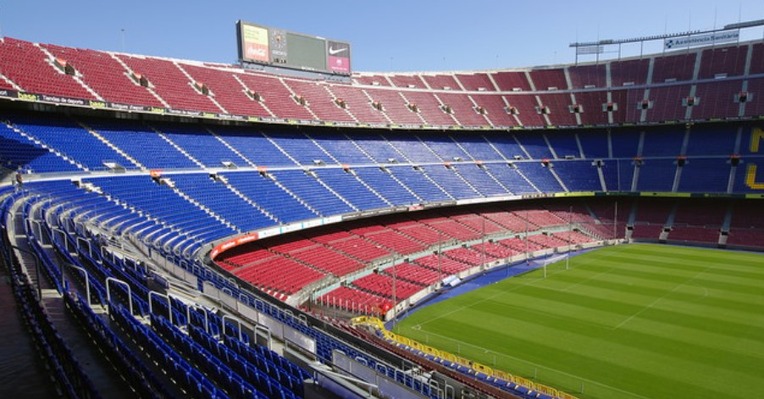
Camp Nou Seating Plan and Where to Sit
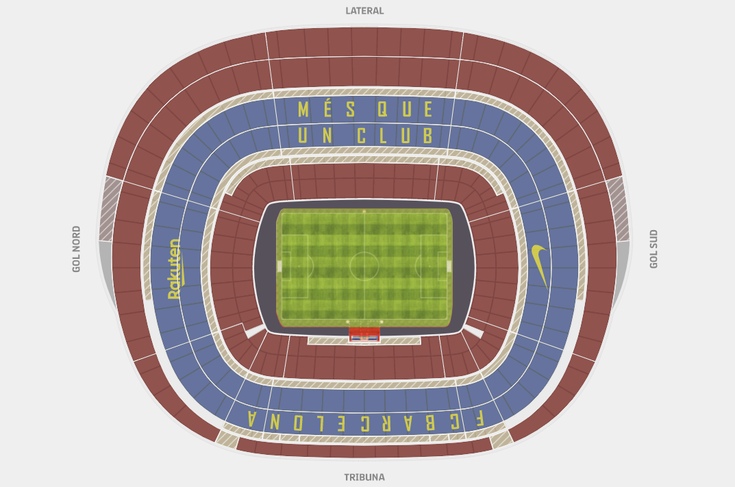
As is the case with most European stadiums, the Nou Camp is built in a ‘Bowl Style’ of continuous seating rather than the ‘English Style’ of having four distinct stands on each edge of the pitch that you might be used to. The stands are, essentially, named after their geographical locations. Here’s a bit of information on each:
- The North Stand – The whole ground has three distinct tiers of seating, with The North Stand being no exception. It is behind one of the goals and is incredible to look at.
- The East Stand – Noticeable because of the saying ‘MES QUE UN CLUB’, or ‘more than a club’, which is spelt out on the seats, The East Stand runs along the side of the pitch.
- The South Stand – Essentially a replica of The North Stand, this stand is behind the other goal and, even though Spanish stadiums don’t tend to have specific areas where the noisiest fans go like English grounds do, this part of the stadium welcomes the more vocal Barca fans. That’s probably because the upper section of this stand is where the away supporters are placed.
- The West Stand – Running along the opposite side of the pitch to The East Stand, The West Stand is the main stand in the ground and houses the changing rooms, the players’ tunnel, the dugouts and the VIP section. It is also the only part of the coliseum-like stadium that has a roof.
Barcelona Ticket Prices
The Nou Camp is massive. Like really, really big. So the prices reflect the fact that there are loads of different places within the ground that you can sit. Because of that there aren’t necessarily different prices for different ages or those people, such as concessions, that would normally expect a discount. Rather the different parts of the ground have different prices associated with them. The club also charge different prices based on the opposition.
Here’s an example of the spread of the cost you are most likely to see:
- All tickets: €64 – €176
How To Get Barcelona Tickets
Spain operate a slightly different ticketing policy to the one you might be used to in England, with match tickets usually not going on sale until two weeks before the game. Once you get to that point and the tickets have been released then you can buy them by calling the club’s ticket office on the phone, going to the ticket office windows at the ground itself, heading to Barcelona’s official website or even purchasing them through various Servicaixa cash points located around the city.
Where to Buy
Getting To Camp Nou
Barcelona may not be the capital of Spain but it is still one of the country’s most famous cities. As such it’s relatively easy to get to, with the Nou Camp itself also being a reasonably simple place to visit. Here are the methods you’ll want to look at:
Train – Getting the train from London to Barcelona, for example, will take just shy of nine hours and whilst it’s actually quite a fun journey – taking in Paris and some wonderful sights on the way through Spain, you’ve got to be pretty dedicated to want to go that way. That said, once you’re in Barcelona the Metro is your friend. There are four stops within easy walking distance of the ground; namely Palau Reial and Les Corts on Line 3 and Collblanc or Badal on Line 5.
There is also a tram system in Barcelona, with six different stops in easy reach of the stadium. Lines T1, T2 and T3 all go where you need them to and you’ll want to jump off at one of Maria Cristina, Pius XII, Palau Reial, Zona Universitaria, Avinguda de Xile or Sant Ramon.
Bus – Camp Nou is about five kilometres West of the historic centre of the city, so there are plenty of buses available to take you near to the ground – even if the Metro is the easiest and most sensible route. Bus numbers 7, 15, 33, 43, 56, 63, 67, 68, 70, 72, 74, 75, 78, 113, 153, 157, 158 and 167 all stop close to the ground.
Car – Driving in Barcelona is notoriously tricky, though if you’re determined to do it then we recommend you get yourself a sat-nav and put in the address of the stadium: C. Aristides Maillol, 12, 08028 Barcelona.
By Air – Barcelona International Airport is 13km to the South-West of the city and is the main one that serves the area. There’s a train and a bus that runs from the airport into the centre, too, so transport links are good. Gerona Airport and Reus Airport are both over 100km away and are therefore cheaper to fly into but will cost more to get to the Nou Camp from.
Taxi – A taxi from Barcelona International Airport to the Nou Camp will take somewhere in the region of twenty minutes to complete its journey and should cost approximately €25, depending on whether it gets stuck in traffic.
Parking Near Camp Nou
Parking is available for Members on match days but you need a parking permit in advance and they’re not all that easy to come by. Parking is available on Carrer Joan d’Alós, but keep an eye out for various parking restrictions. You can park at the nearby Hotel Reina Sofia and at the time of writing that will set you back €10.
Useful Resources
Camp Nou Hotels
Barcelona is a popular tourist destination so there are loads of places to stay in one of Spain’s most beautiful cities. Here are some of our favourite options that are all less than half a mile from the ground:

Yellow Nest Hostel - £70+
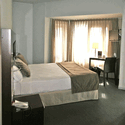
Hotel Madanis Liceo - £90+
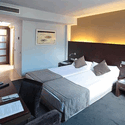
Hotel Madanis - £90+
Pubs and Bars Near Camp Nou
Much like with its hotels you can barely go a few foot in Barcelona without finding an excellent little bar that you’ll be desperate to pop in to. Here are some of our recommendations for a pre-match pint:
Bar Guajiro
Karaoke Nick
The Wild Rover Irish Pub
Facilities
The facilities at the Nou Camp are pretty much exactly what you’d expect from one of the biggest and most famous football stadiums in the world. There are places to buy food and drink on the concourses as well as all of the usual things such as toilets.
Hospitality
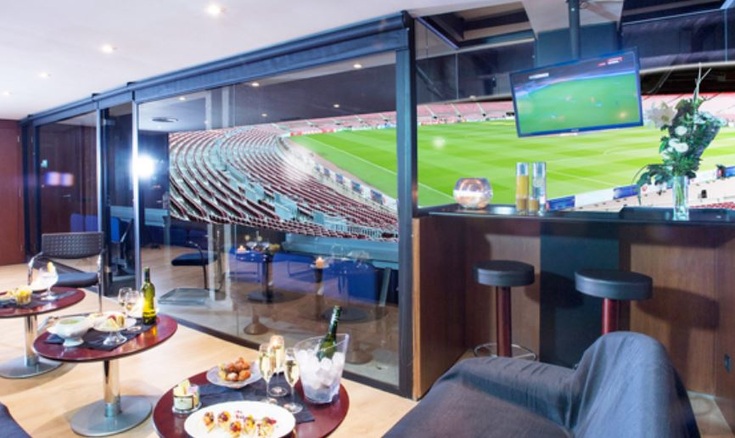
Match day hospitality abroad is often a quite different beast to the sort of thing you may be used to experiencing in the UK. Sometimes it’s more about paying big bucks in order to have a comfortable seat with a great view, for example. Here is some information on some of the packages that are on offer at the Nou Camp:
- VIP Gold – These seats are sold as being amongst the best in the stadium and considering they’re right by the dugouts its easy to see why. You’re close enough to the action to see the expressions on players’ faces and you’ll also get access to the VIP lounge called Avantllotja d’Honor.
- VIP Palladium – From one extreme to the other, with the VIP Palladium seats being located on the third tier of the Grandstand. They’re in a section that is covered by the roof, however, and you also get access to The Roma ’09 VIP Lounge included with your ticket.
- VIP Silver Gol – Your seat with this package is in the front row of the second tier of The South Stand, behind the goal. As well as being able to watch all of the action from an ideal vantage point you can also go into one of two lounges: The Mediapro Lounge and The Avantillotja Lateral VIP Lounge are both their for your amusement.
Private Hire
Company meetings, presentations, birthday parties, 7-a-side tournaments and even weddings can now be held at the Camp Nou. It wasn’t always the case, but Barcelona have begun to realise it’s a great way to make money at the same time as giving fans access to the ground of their heroes in a way that simply wasn’t possible before.
Stadium Tours & Museum
As is the case with most of the major clubs in Europe, Barcelona aren’t stupid when it comes to things like making money from tours. Adults will pay €28 to do the tour, whilst kids from 6-13 and concessions over the age of 65 will pay €21. For the price you will get to see truly behind-the-scenes locations such as the magnificent players’ tunnel, the pitch side and dugouts, the press area and, of course, the trophies that Barca have won over the years. Your ticket price also includes entrance into the club museum.
The tour is self-guided with the aid of a listening device, so it can essentially take as long as you’d like it to. As there are plenty of interact displays and things around we’d recommend that you leave at least an hour and a half for your experience. The tour is open from 9.30am until 7.30pm in the summer months, from 10am until 6.30pm in the winter months and from 10am until 2.30pm on the Sundays of winter months.
About Barcelona
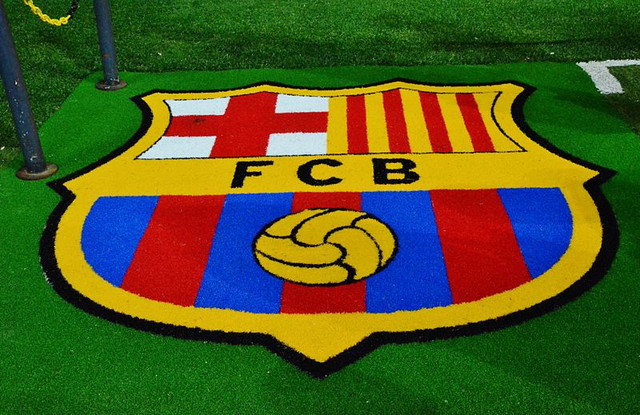
There’s not much to say about Barcelona, presuming you don’t want to talk about their players, their manager, their fans or their historic success. If you do want to chat about those things, however, then we could be here all day. The club was formed in 1899 by a group of footballers including some Swiss and English players as well as some Catalan names. It is considered to be the second most valuable sports team and the second most valuable football team in the world behind the club’s biggest rivals, Real Madrid. Not bad for a football club that is owned and operated by its supporters.
As far as the club’s successes are concerned they are numerous and impressive. They’ve won 27 La Liga titles, 31 Copa del Rey trophies and they have won a record number of Supercopa de Espana, Copa Eva Duarte and Cope de la Liga trophies. Internationally they’re no slouches either, having won the European Cup five times, the UEFA Cup Winners’ Cup a record four times, the UEFA Super Cup a record-sharing five times. They’ve been ranked first in FIFA’s Club World Ranking on several occasions, most recently in 2015.
Camp Nou History
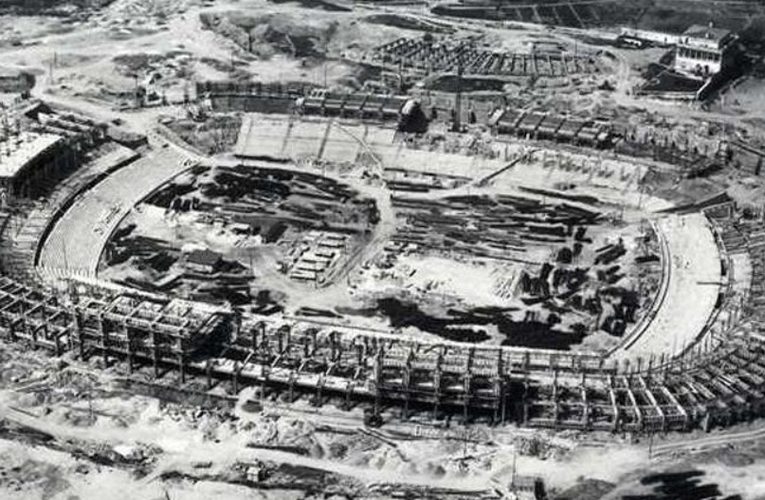
Barcelona originally played their games at the 6,000 capacity Camp de la Industria, moving in 1922 to the Camp de Les Corts that could welcome 20,000 spectators. The club continued to grow after the Spanish Civil War and that led to the Camp de Les Corts continually expanding until it could hold 60,000 fans without issue. At that point, however, there was no further room for expansion and back-to-back titles in 1948 and 1949 saw a further surge in the club’s membership. The only option seemed to be to move to a new location and the building work for the Camp Nou began in March of 1954. Its official name was Estadi del FC Barcelona and it was only called Camp Nou unofficially. That changed in 2000 when fans were polled on their preferred name and voted overwhelmingly in favour of the latter.
The building of the club’s new home took over three years and cost 288 million pesetas, a remarkable 336% more than the initial budget laid out for its construction. In 1980 the ground underwent some severe redesigning in order to make it compellable with new UEFA criteria and to get it ready for use in the upcoming 1982 FIFA World Cup. The club raised money for the expansion and development by giving supporters the chance to inscribe their name onto the bricks that would be build for the construction for a small fee. Further redevelopment took place in preparation for the stadium’s use for the 1992 Summer Olympics, with two more tiers of seating being added above the previous ones.
Future Developments

It was announced in January of 2014 that the club would not move to a new home, instead investing nearly €600 million in order to expand the stadium to a capacity of 105,000. The work, expected to take 4 years to complete, was scheduled to start in 2017, but after delays only began in 2023 to be completed by 2026. It will be a very snazzy affair, with a retractable roof covered in 30,000 square metres of solar panels, to power a screen running around the whole upper tier of the stadium; it will also be able to collect and recycle rain water… if they ever get it finished of course.
In the meantime, Barcelona are playing at Estadi Olímpic Lluís Companys.
